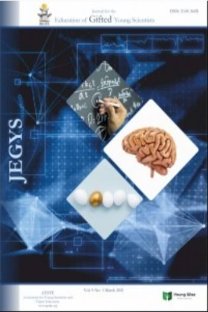Formulation of Word Problems in Geometry by Gifted Pupils
This study investigated the ability level of talented and gifted pupils to define selected geometry terms and formulate a word problem for each of them. In order to perform this task correctly, pupils should be acquainted with the geometry term. Moreover, they must have at last experience in solving word problems. The research population consisted of 58 pupils from the 4th-6th grades who learn mathematics in a course which is adjusted to their high ability level. The research findings illustrate a medium level of mastery of the term definition knowledge. The formulated word problems were mainly taken from the pupils' previous experience and they are at the first level according to van Hiele. Only few pupils demonstrated creativity and write problems which were not similar to the ones they knew from the textbooks.
___
- Alcock, L., & Simpson, A. (2002). Definitions: Dealing with Categories Mathematically. For the Learning of Mathematics 22(2), 28-34.
- Cifarelli, V. (1999), Abductive inference: connections between problem posing and solving. Proceedings of the 23th PME, Haifa, 2, 217-224.
- English, L. N. (1998). Children’s problem posing within formal and informal contexts. Journal for Research in Mathematics Education, 29(1), 83-107.
- Greer, B. (1993). The mathematical modeling perspective on wor(l)d problems. Journal of Mathematical Behavior, 12, 239-250).
- Hershkovitz, S., & Nesher, P. (2003).The role of schemes in solving word problems. The Mathematics Educator, 7(2), 1-24
- Hershkovitz, S., Peled, I., & Littler, G.(2009).Mathematical Creativity and giftedness in elementary school :Task and teacher promoting creativity for all. In : Creativity in mathematics education of gifted students(255-271).Edited by: Leikin, Berman, Koichu. Sense publishers,
- Hiebert, J. (1986). Conceptual and procedural knowledge: The Case on Mathematics. Hillsdale, NJ: Erlbaum.
- Levenberg, I., & Ophir, S. (2006). Is it possible to tell about numbers? Reflection and Research in Teacher education, 10, 1-7. [Hebrew]
- Morgan, C.(1996). Language and assessment issues in mathematics education. Proceeding of the 20th conference of PME. Valencia, Spain, 4, 19-25.
- Mountwietten, M., & Vinner, S. (1995). Processes of acquiring mathematical terms by means of definitions and examples among elementary school pupils. Theory and Practice in Studies Planning, 10, 149-161. [Hebrew]
- Murray, H.(2012). Problems with Word Problems in Mathematics. Learning and Teaching Mathematics, 13, 55-58.National Council of Teachers of Mathematics (2000).Principles and Standards for School Mathematics. Reston, Va.: NCTM.
- Patkin, D. (2014). Global van Hiele (GVH) Questionnaire as a tool for mapping knowledge and understanding of plane and solid geometry. Journal of the Korean Society of Mathematical Education. Series D: Research in Mathematical Education, 18(2), 103-128.
- Patkin, D., & Levenberg, I. (2012) Geometry from the world around us. Learning and Teaching Mathematics. A Journal of AMESA, 13, p.14-18.
- Renzulli, J. S. (1978). What makes giftedness? Reexamining a definition. Phi Delta Kappan, 60, 180-184, 261.
- Renzulli, J. S., Koehler, J. & Fogarty, E. (2006).”Hound tooth operation intervention theory”. Gifted child today, 29,15-24.
- Sheffield, L. J. (2009).Developing mathematical creativity-questions may be the answer. In: Creativity in mathematics education of gifted students(72-85).Edited by: Leikin, Berman, Koichu. Sense publishers,
- Shir, K., (2004). Learning of a super-term in mathematics: The case of the term mathematical definition. Ph.D. thesis. Haifa: Technion – Technological Institute of Israel.[Hebrew]
- Shir, K., & Zaslavski, A. (2003).The way pupils perceive the role of mathematical definitions. A paper presented at the Hemi conference – the Organisation for the promotion of mathematical education in Israel, Department of Technology and Sciences Teaching, Technion – Technological Institute of Israel, Haifa, 20 May 2003.
- Silver, E. (1996).An analysis of arithmetic problem posing by middle school students. Journal for Research in Mathematics Education, 27(5), 521–539.
- Shore, B. M., & Kanevsky, L. (1993). Thinking processes: Being and becoming gifted. In K. A. Heller, F. J. Monks, & A. H. Passow (Eds.), International Handbook for Research and Development on Giftedness and Talent (pp. 133-148). London: Pergamon.
- Skemp, R. (1997) Relational understanding and instrumental understanding. Mathematics teaching, 77,20-26.
- Tannenbaum, A.J. (1983).Gifted children: Psychological and emotional perspectives. New York: Macmillan.
- Taylor, P.(2009)Challenge in mathematics learning-where to from here? In : Creativity in mathematics education of gifted students(72-85).Edited by:Leikin, Berman, Koichu. Sense publishers,
- Usiskin, Z.(1996).Mathematics as a Language .In Communication in Mathematics, K–12 and Beyond, 1996 Yearbook of the National Council of Teachers of Mathematics (NCTM).
- Van Hiele, P.M.(1987). Van-Hiele Levels, A Method to Facilitate the Finding of Levels of Thinking in Geometry by Using the Levels in Arithmetic. Paper Presented at the Conference on Learning and Teaching Geometry: Issues for Research and Practice. Syracuse University.
- Van Hiele, P. M. (1999). Developing geometric thinking through activities that begin with play. Teaching Children Mathematic, 5 (6), February 1999, 310-316.
- Vinner, S. (1991).The role of definitions in teaching and learning of mathematics. Advanced Mathematical Thinking, 5, 65-81.
- Yelin, K., &Zaslavski, A. (2000).Perception of pre-service teachers of the concept mathematical definition. A paper presented at IALA Conference – Israeli Association for the Research of Education, 12. Tel Aviv: Tel Aviv University, 25 October 2000. [Hebrew]
- Başlangıç: 2013
- Yayıncı: Genç Bilge Yayıncılık
